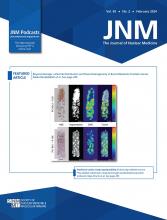TO THE EDITOR: We read with great interest the recent article by Kumar et al. published in The Journal of Nuclear Medicine (1). The authors presented an intriguing finding of clinically significant hypocalcemia and osteosclerosis as rare but important side effects of 177Lu-PSMA-I&T therapy in patients with high-volume osseous metastatic disease who showed a significant treatment response. The paper provides valuable insights and stimulates thought; however, there are still certain aspects that require further clarification and discussion. Although Kumar et al. shed light on the potential side effects of 177Lu-PSMA-I&T therapy, additional investigation is necessary to fully comprehend the underlying mechanisms and optimize patient management.
Hungry bone syndrome was initially described by Albright and Reifenstein in relation to the removal of parathyroid adenomas (2). This procedure triggers an increase in osteoblastic activity, resulting in excessive deposition of calcium and phosphate in the bones (3). The calcium sink effect in metastatic prostate cancer, which is also associated with hungry bone syndrome, is actually caused by tumor-induced osteoblastic activity (4). These cases generally do not respond well to aggressive medical treatment but may show improvement after successful tumor control (1,5,6).
We posit that the findings of Kumar et al. may differ from the tumor-induced calcium sink effect. According to their study, patients who were previously normocalcemic experienced hypocalcemia after 177Lu-PSMA therapy, specifically when there was significant tumor suppression. The authors hypothesized that the remaining minority of tumoral cells may have increased the release of osteoblastogenic growth factors. However, we propose that the underlying pathophysiology might be explained by considering the fact that prostate cancer cells have the ability to secrete parathyroid hormone–related peptide, thereby stimulating osteoclast activity. Tumor suppression consequently results in significant suppression of parathyroid hormone–related peptide in the microenvironment, leading to hypocalcemia that closely resembles hungry bone syndrome (7,8). Unfortunately, Kumar et al. did not provide any data regarding the levels of parathyroid hormone–related peptide in the cases to assess this hypothesis. Furthermore, it would have been valuable to evaluate whether changes in calcium levels correlate with changes in prostate-specific antigen and prostate-specific membrane antigen levels in the bone-only metastatic subgroup.
Kumar et al. have also introduced intriguing concepts regarding the Tyr phenomenon and its potential impact on bone marrow reserve. However, their report lacks supportive data on this matter. The authors propose that an excessive osteoblastic reaction may lead to a decrease in the bone marrow reserve. To substantiate this assertion, it would have been beneficial if they had presented the changes in hemoglobin levels among patients experiencing albumin-corrected hypocalcemia after 177Lu-PSMA therapy and compared them with the original dataset.
In their approach to mitigate the undesired exaggerated osteoblastic reaction, the authors used glucocorticoid therapy, which appears to be a reasonable strategy. However, it is worth considering 223Ra therapy as a potential alternative since it can inhibit osteoblastic activity and has demonstrated its efficacy in controlling refractory tumor-induced hypocalcemia (9,10).
Emran Askari, Sara Harsini*
*BC Cancer Research Institute Vancouver, British Columbia, Canada
E-mail: sharsini{at}bccrc.ca
Footnotes
Published online Sep. 21, 2023.
- © 2024 by the Society of Nuclear Medicine and Molecular Imaging.
REFERENCES
- Revision received July 14, 2023.
- Accepted for publication July 20, 2023.







